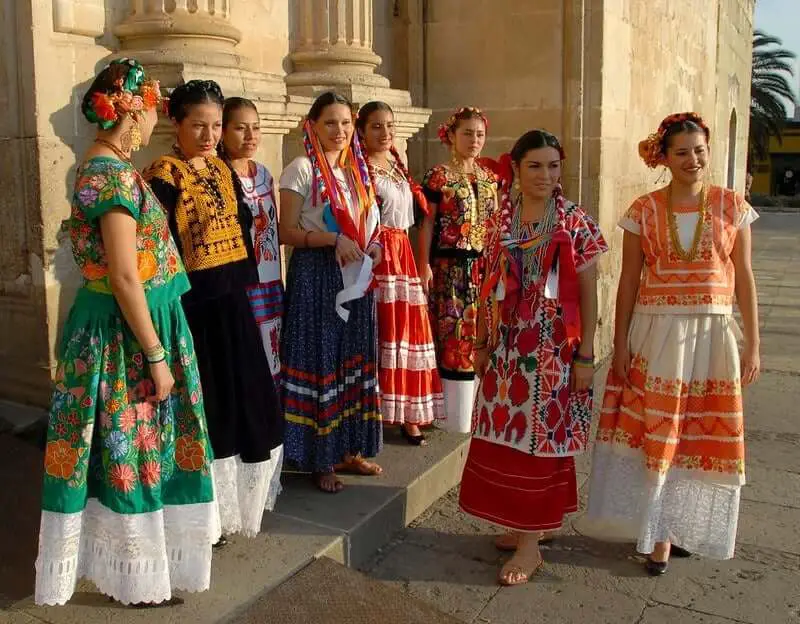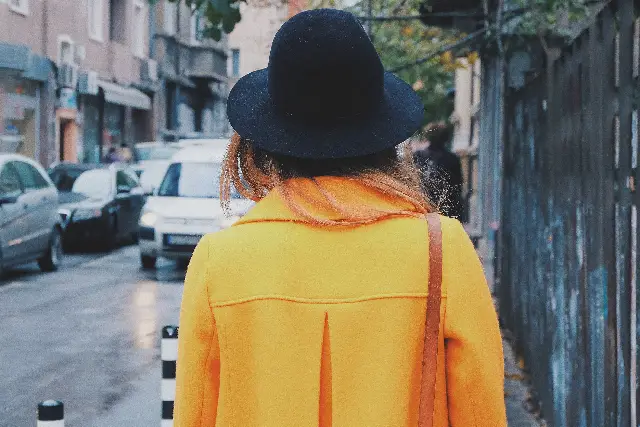Traditional Mexican clothing showcases a rich heritage. Women often wear “huipil” blouses, with intricate embroidery, preserving centuries-old designs. Men sport “charro” suits, rooted in horsemanship, including sombreros. Regional variations reflect diverse indigenous cultures, like Oaxaca’s “tehuana” attire. Embrace Mexico’s history through its iconic garb.
What Influences the Mexican Traditional Clothing?

These regional variations are most apparent in the types of fabric used to make clothing articles, such as sombreros (hats), ponchos (coats), and huaraches (a type of sandal).
However, traditional Mexican clothing is also rooted in Spanish culture and Catholic tradition. Many of the items under this umbrella have been imported from other countries to create a distinct style. So, while the general look will be familiar to anyone who has visited Mexico or watched telenovelas (soap operas), there may still be a few surprises.
What is the History of Mexican Traditional Clothing?
Traditional Mexican clothing is a blend of Spanish influence and indigenous traditions. According to historians, indigenous Mexicans wore plant fibers, animal fibers, or wool clothes.
These early peoples also wore various types of jewelry, headdresses, and masks when performing religious ceremonies. As the Spanish Empire expanded, influences from the Catholic Church and the Spanish aristocracy were brought to the New World. Spanish colonists introduced the custom of wearing long and flowing garments, including the vestments worn in churches and the shawls worn by the nobility.
These robes were often made of expensive fabrics, including silk, velvet, and brocade, to help the Roman Catholic Church sustain itself.
Types of Traditional Mexican Clothing
The types of traditional Mexican clothing are distinguished by the items used in their construction, such as yarn, thread, or even paper. A few examples of traditional Mexican clothing include:
1. Sombreros
Sombreros are one of the most iconic pieces of traditional Mexican attire. They are typically made of straw, alpaca, or a coarse fiber called huarache. Although they are usually worn slanted, each sombrero’s size, shape, and color differ across regions.
Some men wear a sombrero indoors or when farming, while others wear a sombrero at weddings, baptisms, and other celebrations.
2. Ponchos
Ponchos are a coat worn over a blouse, dress, or shirt to protect the wearer from the elements. The most popular poncho material is cotton. They are mostly worn during rainy seasons or when it is more relaxed. Ponchos can be made of wool or alpaca.
3. Huaraches
These are sandals made of leather, rubber, or cloth. They are similar to traditional Mexican footwear worn by many indigenous tribes across Mexico. Some huaraches are made of multiple pieces of leather and are strapped together.
During festive occasions, many people wear huaraches with skirts or dresses.
The Mexican Traditions and Customs
Various customs and traditions are associated with traditional Mexican clothing. Many outfits are worn during religious celebrations such as weddings, baptisms, quinceañeras (15th birthday parties for girls), and graduations.
During these events, clothes are often worn as symbols of love. In addition, the traditional clothing worn during these events often has a spiritual meaning. Another tradition common in many parts of Mexico is specific clothing items to celebrate local traditions or traditions related to one’s family.
For example, people living in southern Mexico often wear clothing items made of gold to celebrate the Catholic tradition of celebrating the Day of the Dead. This tradition is related to the indigenous tradition of honoring ancestors.
Modern Mexican Clothing: How Does It Compare to the Traditional Clothing?
Mexican clothing, rich in its cultural heritage, has evolved from the traditional garments of the indigenous people to the contemporary styles influenced by global fashion trends. Here is a comparison between the modern Mexican clothing and the traditional ones:
1. Material Usage
Traditional: Ancient Mexican clothing was typically made from locally sourced materials like cotton, agave, and bark. Textile techniques from pre-Hispanic cultures, including weaving, embroidery, and brocade, were often used in the garment’s creation.
Modern: The materials used in modern Mexican clothing have significantly transformed. Mexicans today commonly wear clothes made from synthetic materials like polyester and nylon due to their cost-effectiveness and durability. However, traditional materials and techniques are still used in some boutique or cultural fashion.
2. Design and Patterns
Traditional: Traditional Mexican clothing is characterized by vibrant colors, intricate patterns, and detailed embroidery. These elements often represent specific regional identities and historical influences.
Modern: In contrast, modern Mexican clothing takes cues from global fashion trends. Mexicans today wear common Western-style clothes like jeans, t-shirts, suits, and dresses. Nonetheless, traditional influences can still be seen in colorful embroidery or indigenous-inspired patterns on modern garments.
3. Women’s Clothing
Traditional: A typical traditional outfit for women consists of a ‘huipil’ or ‘blouse’, a ‘rebozo’ (a long shawl), and a long skirt. These items feature colourful and elaborate designs that signify one’s cultural identity.
Modern: Modern Mexican women’s fashion largely follows international trends with staples including pants, skirts, blouses, and dresses. Nonetheless, traditional garments like the rebozo or modern variations of it can be commonly seen on special occasions or during cultural celebrations.
4. Men’s Clothing
Traditional: Traditional Mexican men’s clothing might include ‘charro’ suits or simple white cotton shirts and pants called ‘guayaberas.’ Embellished capes known as ‘sarapes’ were also popular amongst men.
Modern: Today’s Mexican man typically dons western attire such as suits, trousers, shirts, and jeans. However, on cultural or festive occasions, they might wear modern interpretations of the charro suit or the guayabera shirt.
5. Usage
Traditional: Traditional clothes were formerly daily wear but are now mainly used during festivals, weddings, or other special occasions to celebrate Mexican heritage.
Modern: Modern clothing in Mexico is significantly more diversified in terms of use and is part of everyday attire suited for work, school, or casual outings.
In conclusion, while Mexican clothing has indeed embraced modern fashion trends and materials over the years, it continues to uphold its rich cultural heritage. This mesmerizing fusion of traditional roots with contemporary style forms the unique characteristics of modern Mexican fashion.
The Popular Designs in Mexican Dress
Traditional Mexican clothing is often worn during festive celebrations, such as weddings and Quinceañeras. However, traditional Mexican attire can be worn at any event where it is appropriate.
Many traditional Mexican clothing items are worn during daily life. The most commonly worn traditional Mexican clothing items in Mexico include:
- Blouses: Blouses are the most common item worn under traditional Mexican clothing. They are typically made of cotton, silk, or synthetic material. The color of the blouse depends on the occasion.
- Skirts: Traditional skirts are worn during daily life instead of traditional Mexican clothing worn during festivities. They come in all sizes and lengths, depending on the wearer’s preference.
- Shorts: Shorts are another common item worn in traditional Mexican clothing, although they are not always made of traditional Mexican dress fabric.
Which Fabrics are Traditionally Used to Make Traditional Mexican Clothing?
Traditional Mexican clothing is made from various articles, including huaraches (sandals), ponchos, sombreros, shirts, blouses, skirts, and shorts. The fabric used to make these articles varies across Mexico, as do their colors.
Certain regions of Mexico may use one type of fabric to make Traditional Mexican Clothing. For instance, the garments worn in Oaxaca may be made with a coarse cotton cloth, while the clothing worn in the state of Jalisco may be made with a piece of silk fabric.
Where to Buy Authentic Mexican Clothing and the Buying Tips

Are you enthusiastic about traditional Mexican clothes but don’t know where to buy them? Sit pretty, keep reading, and you will soon find the ideal places to buy the items.
Many Traditional Mexican Clothing items are still handmade in Mexico, although the materials and designs used to make these items have changed over time. To purchase authentic Traditional Mexican Clothing, one must find a seller that sells genuine items.
It is best to avoid purchasing mass-produced items made from synthetic materials. Instead, look for Traditional Mexican Clothing made from natural fabrics, such as cotton, wool, silk, or blends of these materials.
It is also essential to purchase Authentic Mexican Traditional Clothing items from a reputable seller. The best way to do so is by visiting a Traditional Mexican dress-making and attending a fair. These events usually occur across Mexico and feature vendors specializing in authentic Mexican Traditional attire.
The Evolvement of the Mexican Traditional Clothing

- The Pre-Columbian Era:
During the pre-Columbian era, before the arrival of the Spanish, Mexican clothing was simple yet functional. The attire was made from natural elements like animal skins, cotton, agave, and yucca. Men typically wore loincloths while women adorned huipils (a type of tunic) and simple skirts.
- The Spanish Influence:
The Spanish colonists brought novel elements to Mexican fashion between the 16th and 18th centuries. They introduced silk, wool, lace, and linen, replacing the basic materials used previously. Traditional clothing was transformed from mere utility wear to intricate and decorative attire. Women wore full skirts and blouses while men wore trousers and shirts.
- The Independence Era:
Mexican clothing during the independence movement in the early 19th century portrayed a sense of national pride. Distinct regional styles began to emerge, reflecting the diverse cultural history of the regions. This period witnessed clothes with vibrant colors, intricate embroidery, and traditional symbols.
- Post-Revolution Period:
Post-revolution, the Zapatistas and Adelitas’ attire became popular. Women wore long skirts and blouses with square collars known as China Poblana, while men donned Charro suits with silver detailing. This period marked an emphasis on Mexican roots, demonstrated via traditional attire.
- Modern Twist to Traditional Garments:
In current times, designers blend traditional designs with a modern twist offering a contemporary outlook. Traditional fabrics are being used to create sophisticated yet functional clothing. Designs incorporate vibrant colors, patterns, and embroidery from traditional dresses but maintain a sleek silhouette influenced by Western trends.
| Era | Key Clothes | Influences |
|---|---|---|
| Pre-Columbian Era | Loincloths, Huipils | Nature |
| Spanish Influence | Skirts, Blouses, Trousers, Shirts | Spanish |
| Independence Era | Vibrant colors, Intricate embroidery | National pride |
| Post-Revolution Period | China Poblana, Charro suits | Zapatistas and Adelitas |
| Modern Era | Traditional designs with a modern twist | Western trends |
The evolution of Mexican traditional clothing truly reflects the enriching changes that overtook the nation. From simplicity to intricate designs and elegant styles, the transformation indeed narrates an enchanting story of cultural evolution.
References:
https://www.barcelo.com/pinandtravel/en/traditional-mexican-clothing/
https://www.mexicotravelsecrets.com/traditional-mexican-clothing/

